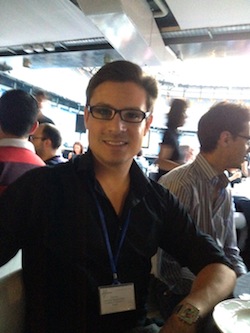The International Workshop on Clouds for Business and Business for Clouds took place last week in Madrid in conjunction with the 10th IEEE International Symposium on Parallel and distributed Processing with Applications. The workshop, organized by Dr. Jose Luis Vazquez-Poletti, provided the perfect meeting point for both industry and academia to explore how business can be migrated to the cloud model.
A Short History So Far
 Cloud computing has acquired enough maturity to expand its field of application to business. Yet there are not only institutions leveraging this paradigm in their production line, there are also those which are offering services through the cloud.
Cloud computing has acquired enough maturity to expand its field of application to business. Yet there are not only institutions leveraging this paradigm in their production line, there are also those which are offering services through the cloud.
The International Workshop on Clouds for Business and Business for Cloud sought to bring together service producers and consumers in order to help them realize the benefits of cloud computing. Technologies, policies and heuristics were shared, as will be outlined below.
The workshop focus originated at the 4CaaSt European Commission FP7 project. There, my “partner in crime” was Dr. Francesco Lelli from the European Research Institute in Service Science. To help foster a successful endeavor, the organizing committee was completed with Professor Dana Petcu, Scientific Coordinator of the mOSAIC European Commission FP7 project.
We encouraged submissions of research papers on work in the areas of cloud computing and service engineering, and especially welcomed papers describing developments in cloud-enabled business process management and all related areas, such as deployment techniques, business models for cloud-based enterprises and experience reports from practitioners.
The Contributions
4CaaSt: Comprehensive management of cloud services through a PaaS
Sergio García-Gómez, Francesco Lelli, Manuel Escriche-Vicente, Pablo Arozarena-Llopis, Yehia Yehia Taher, Christof Momm, Axel Spriestersbach, Miguel Jiménez-Gañán, Goulven Le Jeune, Michel Dao, Stephane P. Carrie, Joerg Niemoller, Dimitri Mazmanov, József Biro, Andrea Giesmann and Frederic Junker
This talk introduced 4CaaSt, which aims at developing a PaaS framework that enables flexible definition, marketing, deployment and management of cloud-based services and applications. The major innovations proposed by 4CaaSt are the blueprint and its management and lifecycle, a one-stop shop for cloud services and the management of resources in the PaaS level (including elasticity). 4CaaSt also provides a portfolio of ready-to-use cloud-native services and cloud-aware immigrant technologies.
The Medianet Project: Integration of Multimedia Services for the next Generations Business-oriented Internet
Jaime Garcia-Reinoso, Guillermo Ibañez, Jose Luis Vazquez-Poletti and Ignacio Martin Llorente
This talk discussed the foundational premises of the MEDIANET project as well as intermediate results obtained during its firsts two years. MEDIANET is a Spanish project founded by the Comunidad de Madrid government, which strives for a significant scientific advance in the future media Internet where important advances are necessary to allow end-users to perceive a good quality of experience.
Towards Cloud-enabled Business Process Management based on Patterns, Rules and Multiple Models
Dana Petcu and Vlado Stankovski
Considered a combination of Software-as-a-Service and Business Process Outsourcing, Business Process as a Service (BPaaSs) has the potential to provide the killer applications able to propel the use of cloud computing to a higher dimension. Following a general overview of the current state-of-the-art in research and implementation of the BPaaS, the speaker proposed a mind switch towards the applicability of re-usable business process patterns and multi-model approach for BPaaS design and deployment. In order to demonstrate the feasibility of the approach, this talk provided two examples of BPaaSs that can be adapted to the proposed approach to obtain clear benefits in terms of services’ efficiency.
A Holistic Model for Making Cloud Migration Decision: A Consideration of Security, Architecture and Business Economics
Bjorn Johnson and Yanzhen Qu.
This talk consolidated several genres of analysis on cloud computing risk. The speaker derived a new analytical model that takes into account business economics, and other business requirements such as various considerations on security and availability.
Incorporating Business Intelligence in Cloud Marketplaces
Anna Gatzioura, Andreas Menychtas, Vrettos Moulos and Theodora Varvarigou
The cloud computing market expands continuously and new service aggregations, customizations and business models are offered in order to cover the needs of all end users. However, even in this new business ecosystem, the question about which offering should be selected still remains. This talk presented an approach for incorporating business intelligence in cloud marketplaces through a mechanism for answering this question based on the individual requirements and use profile of each particular cloud customer.
Revenue Models for Streaming Applications over Shared Clouds
Rafael Tolosana, Jose Angel Bañares, Congduc Pham and Omer Rana
When multiple users execute their streaming applications over a shared cloud
infrastructure, the provider typically captures the Quality of Service (QoS) for
each application at a Service Level Agreement (SLA). Such an SLA identifies the
cost that a user must pay to achieve the required QoS, and a penalty that must be paid to the user in case the QoS cannot be met. This talk analyzed revenue models for in-transit streaming applications, executed over a shared cloud infrastructure under the presence of faulty computational resources. Then, the speaker proposed an architecture that features a token bucket process envelop to accept user streams; and a control loop to enable resource allocation, while minimizing operational cost.
Issue in Automatic Combination of SaaS, PaaS and IaaS
Dinh Khoa Nguyen and Francesco Lelli
Current cloud service description languages envision the ability to automatically combine cloud service offerings across multiple abstraction layers, i.e., SaaS, PaaS and IaaS offerings, to achieve a common shared business goal. However, little effort has been spent in this direction. This talk formalized the issue of automatic combination of cloud services, pointing out its computationally-intensive nature. In order to overcome this issue, the speaker proposed an RDF-based prototype implementation that leverages a batch process for automatically constructing possible combinations of cloud services.
Service Datastores in Cloud Governance
Adrian Copie, Teodor-Florin Fortis, Victor Ion Munteanu and Viorel Negru
Cloud governance is a catalyst for development in the cloud environment because it facilitates easy service management while unburdening SMEs of concerns like cloud management, security and privacy. The proposed governance architecture by this talk is based on mOSAIC’s Cloud Agency, a multi-agent cloud management solution. It is built around a set of specialized datastores, containing different catalogues, which handle all the information the system needs to run. This research is focused on analyzing and detailing governance specific datastores and the way they are able to provide system-wide services.
SDP as a Service (SDPaaS): A New Revenue Stream for Operators
Joaquín Salvachúa and Luis Galindo
This talk focused on the Service Delivery Platform (SDP) concept, which usually refers to a set of components within a telecom operator service architecture that manage easing service creation, deployment and execution utilizing enablers (network capabilities) and service capabilities. The keystone objective of a SDP would be to reduce time-to-market of a service and the key characteristic for an SDP is thus the ability to ease the integration task of application logic with the enablers and capabilities in the telecom service architecture for the delivery of a service to users. The SDP enables thus the rapid transformation of a service concept into a full product including all the related service life cycle management and commercial interactions.
Aggregating Price Models for Composite Services in Cloud Service Marketplaces
Frederic Junker, Juergen Vogel and Katarina Stanoevska
Since the complexity of services and their provisioning is increasing, electronic marketplaces (eMPs) further need to handle the dynamic and automated creation of composite services, i.e., services which are yielded in part by using third-party services available on the marketplace. To meet this requirement, eMPs need a standardized machine-readable description of service offerings. This talk presented an approach to define price models for services traded on eMPs, using a subset of the Unified Service Description Language (USDL). To enable composite service pricing, the speaker introduced approaches on the aggregation of several price models into one price model and analyses the time complexity of the price aggregation algorithm presented.
A Great Experience
Organizing and attending this workshop has been a pleasure. Many interesting ideas have been shared during the event, and the coffee breaks provided another important forum for exchanging points of view between participants. We are glad to announce that this workshop initiated the beginning of a many productive friendships.
It’s clear that both academia and industry have many things to say about business in the cloud and vice versa. Many times we can find a better solution if we just expand our point of view. It is for this reason that we looked for contributors from a range of environments.
Cloud computing is already playing in the big leagues and business is not an exception. With the “big leagues” in mind, I guess we enjoyed the main conference gala dinner even more, as it took place at Santiago Bernabeu Stadium, home of Real Madrid’s soccer team.
About the Author
 Dr. Jose Luis Vazquez-Poletti is Assistant Professor in Computer Architecture at Complutense University of Madrid (UCM, Spain), and a Cloud Computing Researcher at the Distributed Systems Architecture Research Group.
Dr. Jose Luis Vazquez-Poletti is Assistant Professor in Computer Architecture at Complutense University of Madrid (UCM, Spain), and a Cloud Computing Researcher at the Distributed Systems Architecture Research Group.
He is (and has been) directly involved in EU-funded projects, such as EGEE (Grid Computing) and 4CaaSt (PaaS Cloud), as well as many Spanish national initiatives.
From 2005 to 2009 his research focused in application porting onto grid computing infrastructures, activity that let him be “where the real action was”. These applications pertained to a wide range of areas, from fusion physics to bioinformatics. During this period he achieved the abilities needed for profiling applications and making them benefit of distributed computing infrastructures. Additionally, he shared these abilities in many training events organized within the EGEE Project and similar initiatives.
Since 2010 his research interests lie in different aspects of cloud computing, but always having real life applications in mind, specially those pertaining to the high performance computing domain.
Website: http://dsa-research.org/jlvazquez/
Linkedin: http://www.linkedin.com/in/jlvazquezpoletti/


























































